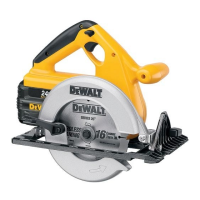18
SECTION E: CORDLESS CIRCULAR SAW DW007
Workpiece Support
Figure E13 shows proper sawing position. Note that hands are kept away from
cutting area.
WARNING: It is important to support the work properly and to hold the saw firmly
to prevent loss of control which could cause personal injury.
ALWAYS DISCONNECT BATTERY PACK FROM SAW BEFORE MAKING
ANY ADJUSTMENTS! Place the work with its ‘good’ side – the one on which
appearance is most important – down. The saw cuts upward, so any splintering will
be on the work face that is up when you saw it.
1. IMPROPER WORKPIECE SUPPORT
A. Sagging or improper lifting of the cut off piece causing pinching of the blade.
B. Cutting through material supported at the outer ends only (see Figure E15). As
the material weakens it sages, closing down the kerf and pinching the blade.
C. Cutting off a cantilevered or overhanging piece of material from the bottom up
in a vertical direction. The falling cut off piece can pinch the blade.
D. Cutting off long narrow strips (as in ripping). The cut off strip can sag or twist
closing the kerf and pinching the blade.
E. Snagging the lower guard on a surface below the material being cut
momentarily reducing operator control. The saw can lift partially out of the cut
increasing the chance of blade twist.
2. IMPROPER DEPTH OF CUT SETTING ON SAW
Using the saw with an excessive depth of cut setting increases loading on the unit
and susceptibility to twisting of the blade in the kerf. It also increases the surface
area of the blade available for pinching under conditions of kerf close down.
3. BLADE TWISTING (MISALIGNMENT IN CUT)
A. Pushing harder to cut through a knot, a nail, or a hard grain area can cause the
blade to twist.
B. Trying to turn the saw in the cut (trying to get back on the marked line) can
cause blade twist.
C. Extended reach or operating saw with poor body control (out of balance), can
result in twisting the blade.
D. Changing hand grip or body position while cutting can result in blade twist.
E. Backing unit up to clear blade can lead to twist if not done carefully.
4. Materials that require extra attention
A. Wet lumber
B. Green lumber (material freshly cut or not kiln dried)
C. Pressure treated lumber (material treated with preservatives
or anti-rot chemicals)
E13
E14
E15

